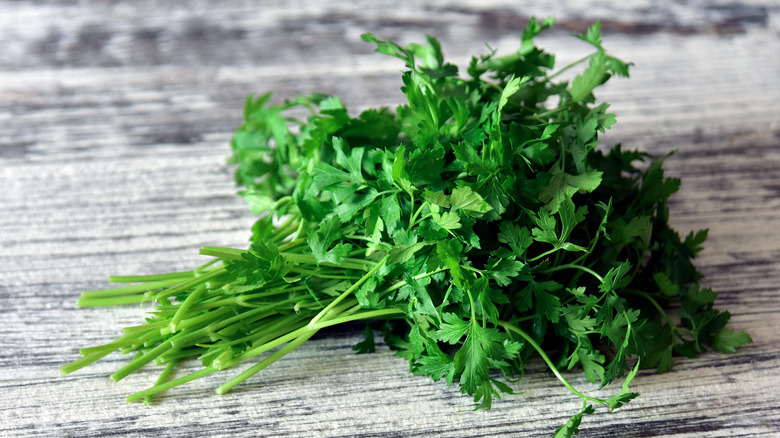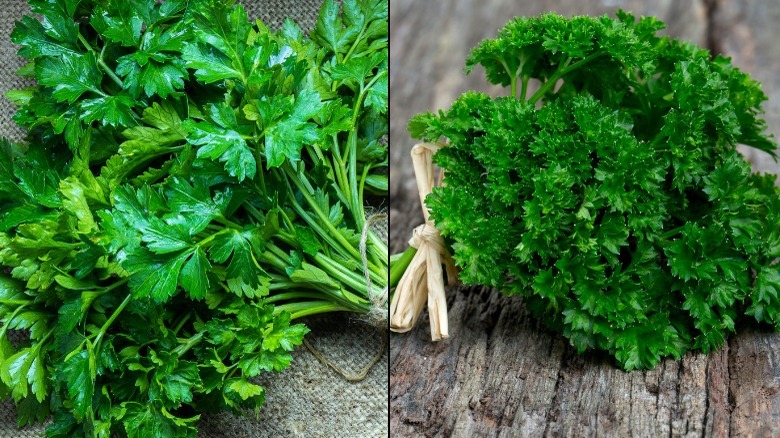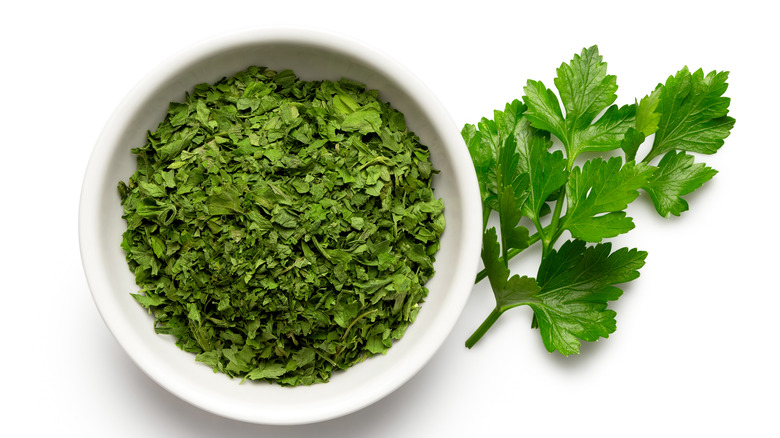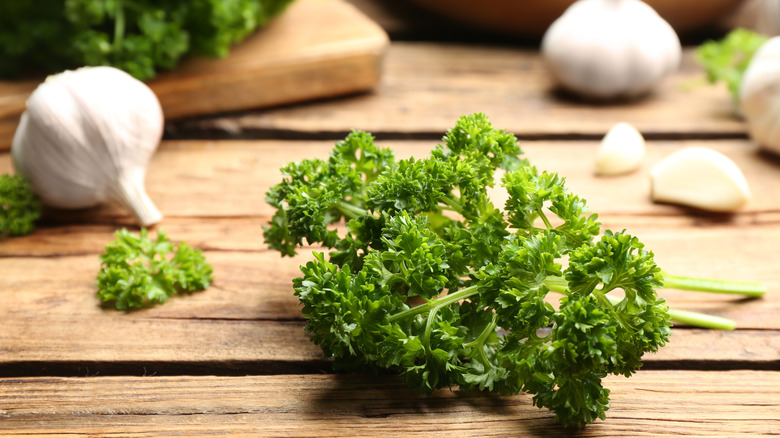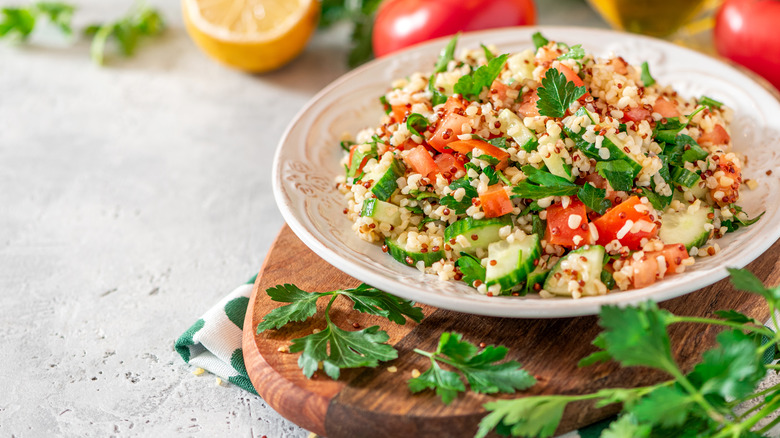Curly Vs. Flat-Leaf Parsley: What's The Difference?
Think beyond festooning your plate with an herbal sprig of green. Both curly and flat-leaf parsley varieties offer unique flavor and texture nuances that can add pizzazz to your recipes. But take note, choose wisely or you may disrupt the outcome of your dish entirely.
When deciding between curly and flat-leaf parsley, you're essentially asking yourself, "French or Italian?" And according to Spiceography, while both herbs share the same name, they part ways when it comes to flavor and texture. The site describes Italian flat-leaf parsley as herbaceous and similar to basil and oregano, while French curly parsley is dubbed grassy, muted in flavor, and — when the leaves are old — downright bitter.
MasterClass explains that curly parsley (Petroselinum crispum) boasts mild-flavored, hearty, ruffled leaves and Italian parsley (Petroselinum crispum neapolitanum) features softer, more flavorful, flat leaves. The leaves of both can be used in cooking, assuming you take taste and texture into consideration. In addition, the robust stems of both varieties make a great addition to homemade stocks, simmered beans, and the classic, multi-herb, bouquet garni.
Same plant family, different tastes
According to Schwartz.com, the term parsley comes from two Greek words: "petrose" meaning "rock" (since the herb often grows amidst stones) and "selenium" which loosely translates to "rock celery." The site adds that parsley's foray into the food world was likely by the ancient Romans, who gobbled up the herb like lettuce, and believed that wearing parsley around the neck prevented drunkenness.
Although both curly and flat-leaf parsley come from the same family — the Umbelliferae, or carrot clan, MasterClass explains that the siblings are quite dissimilar in appearance and flavor.
The site explains that it's the balance of flavor compounds (menthatriene, phellandrene, myristicin, and myrcene) that differentiate the two. Flat-leaf parsley's broad, flat leaves are bold and aromatic, while curly parsley leaves are thicker, ruffled, and deliver a "muted flavor reminiscent of grass, which gets more bitter with time."
Rachel Ray Magazine adds that flat-leaf parsley adds a boost of fresh flavor without overwhelming food, while curly parsley's grassy flavor and saltiness can be hit-or-miss at the table. The magazine also mentions that the curly parsley's sturdy leaves are "more of a pain to chop."
How to cook with flat-leaf vs. curly parsley
AskingLot states that flat-leaf parsley is typically preferred for cooking because it retains its flavor and texture in hot dishes; but since all fresh herbs lose their luster when cooked, it's best to add Italian parsley just before serving. The site adds that curly parsley's bright flavor is excellent in chilled dishes and fresh salads like tabbouleh, where the frilly leaves add flavor and flair to the bulgur-based dish.
And although curly parsley is mainly used as a garnish, perhaps it shouldn't be relegated to the side of the plate. Mitchell Davis, executive vice president of the James Beard Foundation, tells Bon Appétit magazine that curly parsley is perfectly acceptable in any dish calling for flat-leaf. In fact, the chef points out that it's only in the U.S. where you'll find the curly herb demoted to a garnish; in Europe and the Middle East, it's the star of the show in salads and a variety of parsley-based dishes. Cookie and Kate agrees and notes that even when curly parsley is finely chopped, it adds great volume to countless dishes. That said, when making smooth purées like pesto, Inside the Rustic Kitchen prefers flat-leaf parsley because it yields a smoother consistency.
Can you substitute one parsley for the other?
If you have just one parsley in your pantry, consider the recipe before subbing one for the other. Foodiosity notes that curly parsley is more commonly used in French cuisine, so if your recipe is French, it's the frilly herb they're counting on you to use. The Edmonton Journal agrees and asserts that if your recipe specifically calls for one or the other, you should stick with the plan (unless, of course, you don't have it). If that's the case, the journal suggests making the swap only when parsley isn't the main ingredient, otherwise, texture and appearance may be compromised. For example, bright, "clean-flavored" Italian parsley leaves are a colorful, flavorful addition to salads, soups, stir-fries, and pasta dishes. Curly parsley can also add a fresh flavor to many dishes, but it's heartier and voluminous, making it more of a challenge to chop.
Gourmet Sleuth adds that curly parsley is tougher and less flavorful, so if you chop it and swap it in for flat-leaf, the intended taste and texture may be altered. If you're swapping in dried parsley flakes, they recommend a ratio of one tablespoon fresh for every teaspoon dried.
Nutritional value of flat-leaf and curly parsley
Garnish or not, both parsley varieties are nutritious additions to your plate. SFGate states that one tablespoon of parsley contains 9% of your daily recommendation for vitamin C, 7% of your vitamin A, and 82% of your vitamin K. Enhance your salad with one cup of flavorful parsley leaves and you'll be awarded with 21% of the daily recommendation for iron, 23% for folate, and 9% for potassium.
Totally Food notes that parsley contains myricetin, a flavonoid shown to reduce blood sugar levels. Science Direct adds that naturally occurring myricetin may help protect against diabetes, high triglyceride and cholesterol levels, and liver inflammation. Myricetin may also protect against cancer and, when compared to other green herbs and vegetables, parsley contains one of the highest levels of the flavonoid per 100 grams (via Medical News Today).
WebMD reveals that parsley also contains the flavonoid apigenin, a powerful antioxidant that becomes more readily available to your body when the herb is dried and/or cooked. Apigenin may have many health-promoting and therapeutic properties, including the prevention of inflammation, diabetes, Alzheimer's, amnesia, depression, insomnia, and cancer, and the polyphenol serves as a natural treatment for inflammatory disorders (such a multiple sclerosis) and viral infections, according to International Journal of Molecular Sciences.
